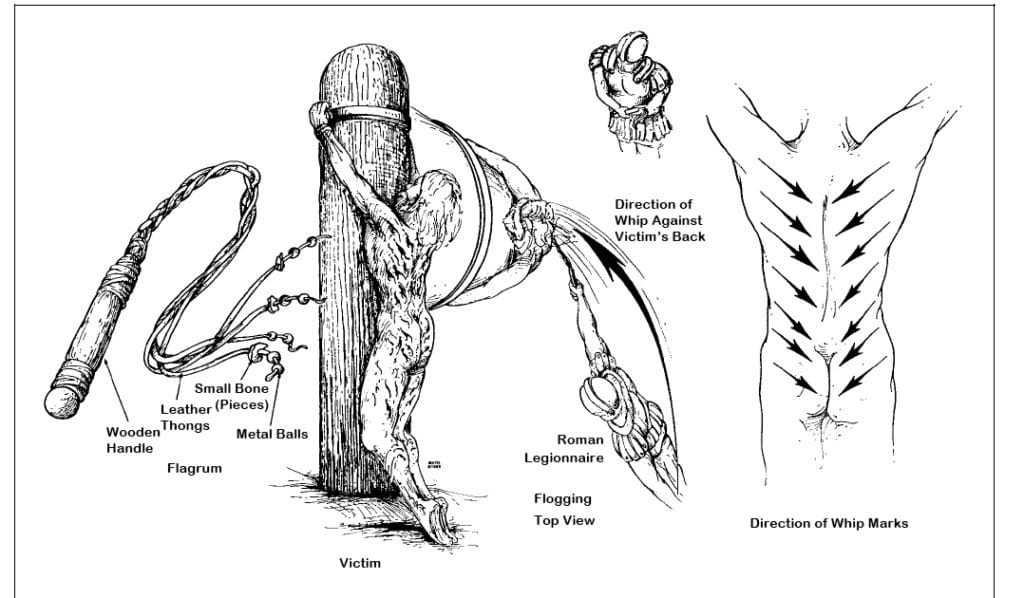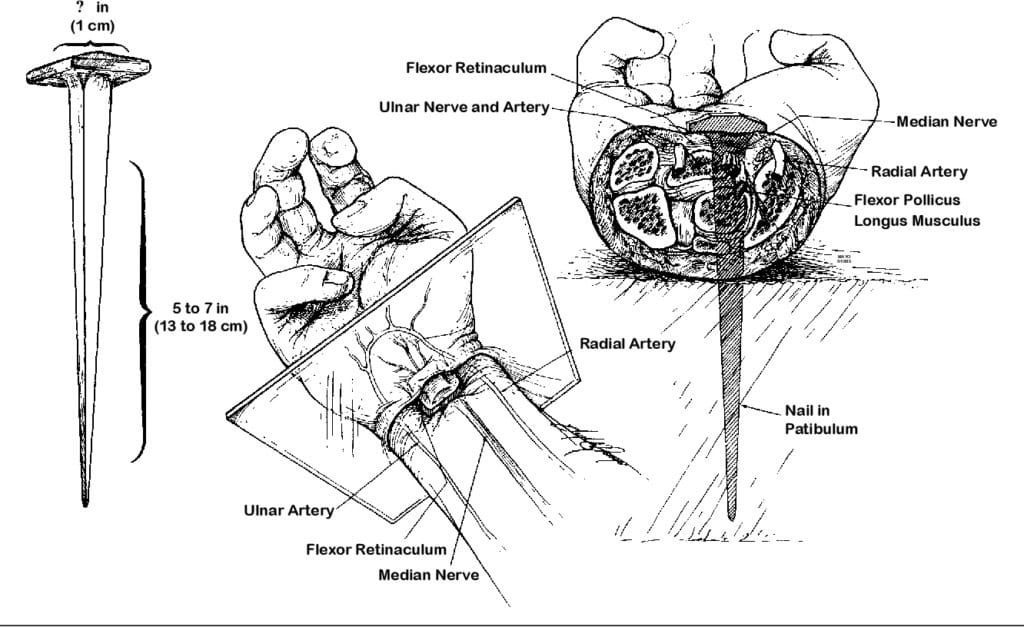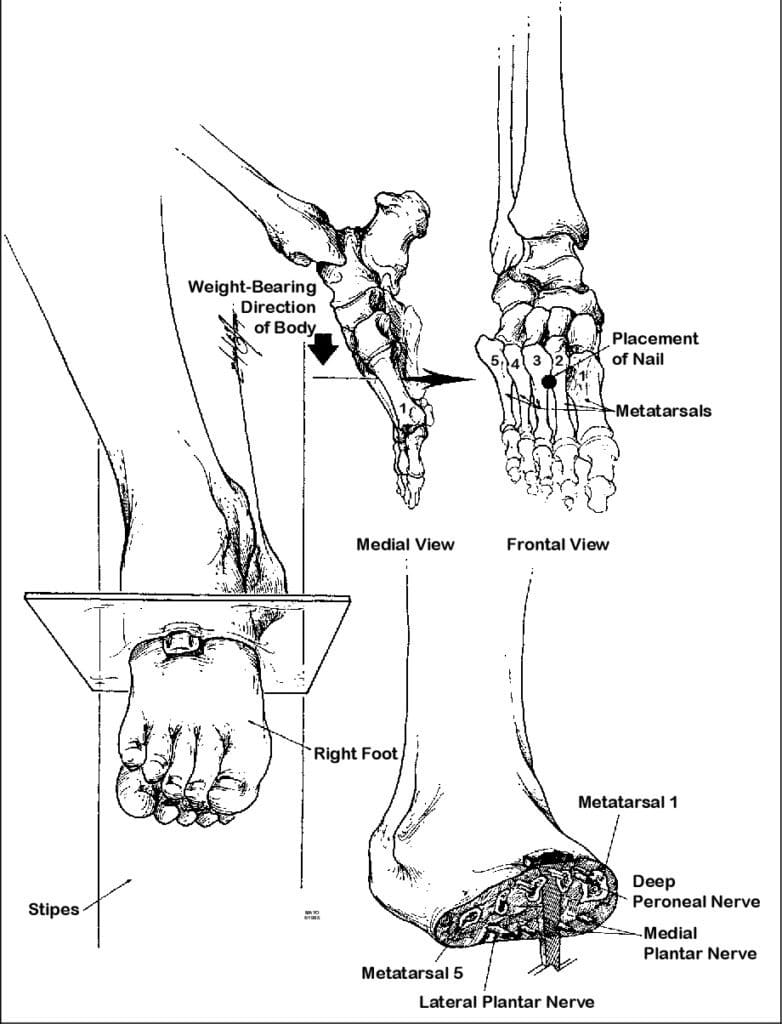While researching to write a paper in seminary, I stumbled across an obscure footnote in a book. It cited an article titled, “On The Physical Death of Jesus Christ.” It was in the The Journal of the American Medical Association, which I knew to be a reputable, peer-reviewed medical journal.1See JAMA, Apr. 1986, vol. 255, no. 11: 1455-63. Accessible online. Now, you can find the article online. In those days, it wasn’t so easy. I had to drive to a medical library to look it up. A medical doctor, William D. Edwards, (with the help of a divinity student) had examined the last hours of Jesus Christ and rendered a medical opinion. Based purely on the biblical data, Dr. Edwards’ article highlighted two words (from Mark 15:15): (1) scourged and (2) crucified.
Note: Diagrams below are from Dr. Edwards’ actual article.
Scourging
Scourging was a violent Roman torture intended to weaken the victim with trauma and blood-loss. It was done in different ways, but often the victim was tied, arms extended, to an upright post. Two Roman soldiers were stationed on either side of the victim. The victim’s back muscles were stretched tight above his head. The soldiers took turns whipping the victim from the side, striking the back, waist area, and legs with force. The whipping instrument (called a “flagellum”) consisted of a handle from which extended several leather thongs. Small pieces of bones, iron balls, or sharp shards were affixed to the end of the leather thongs.

The soldiers would strike, tear into the subcutaneous flesh, twist, and peel back the skin, exposing the skeletal muscle. It was not uncommon to mis-strike the victim and have the leather thongs wrap around the face and eye areas. We are not told how many stripes Jesus endured, but it sufficiently weakened him to the point that he could not carry his own cross.
Crucified
Crucifixion was designed to inflict maximum suffering and death. Weakened by the scourging, the victim was thrown down on the crossbeam, arms extended. The wounds on his back would have been caked with dirt, dust, and splinters. A nail between five and seven inches was hammered either (1) between his two wrist bones or (2) into his palms. The nail was strategically placed to sever the median nerve, causing exquisite pain and partial paralysis of the hand. Most renderings depict this by showing the victim’s hand curled into a claw-like position. The victim was hoisted up. Searing pain would ensue as damaged nerves sent pain screaming throughout the arms and chest.

Once hoisted, the soldiers placed the feet one on top of one another. They would drive a nail through the 2nd and 3rd metatarsal of both feet and then deep into the wooden post. The nail strategically severed both the deep peroneal nerve and the medial plantar nerve, again causing exquisite gyrations of pain throughout the lower extremities.

Common insects would be attracted to the bloody wounds. Birds were known to pick at hanging flesh. Place yourself on that cross for a moment: arms extended; gravity pulling down your internal organs; you only get good oxygen by pushing up against the nails in the feet and hands; nerve damage screaming through your body. Naked. Total desolation. Total humiliation. Total devastation.
Medical Opinion
Dr. Edwards concludes it is not possible to pinpoint any one specific medical malady that caused Jesus’ death:
[I]t may have been multifactorial and related primarily to hypovolemic shock, exhaustion asphyxia [suffocation], and perhaps acute heart failure. A fatal cardiac arrhythmia may have accounted for the apparent catastrophic terminal event.
Dr. William D. Edwards

He then makes a fascinating comment in closing:
The important feature may be not “how” he died but rather “whether” he died.
Dr. William D. Edwards
Some believe Jesus did not die on the cross. In Dr. Edwards’ opinion, the medical evidence suggests Jesus, indeed, was dead.
Why Did Jesus Die?
A deeper question remains for me, though. The physical sufferings of Jesus are incomparable to the spiritual sufferings of Jesus.
It’s not a matter of “how” Jesus died or “whether” Jesus died—but rather, “why” Jesus died.
It’s not a matter of “how” Jesus died or “whether” Jesus died—but rather, “why” Jesus died.
Why did Jesus die? I think I know the answer . . .
He died because of me. My sin. That should be me on that cross, not Him. That should be my back scourged, not His. That should be my median nerve severed, not His. That should be my humiliation, my nakedness, my punishment. That should be my crucifixion, not His. Jesus died to glorify God’s perfect justice toward my sin. He died because He loves me . . . and you.
References
| 1 | See JAMA, Apr. 1986, vol. 255, no. 11: 1455-63. Accessible online. |
|---|




